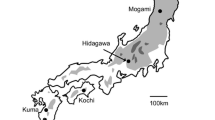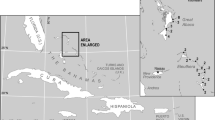Abstract
Tree canopies in forests host exceptional levels of biodiversity. However ecologists are still faced with vast regional gaps in need of fundamental information on the nature of tree canopy diversity. The southern Afrotemperate forests at the tip of Africa are ancient, existing today as a biogeographical string of natural remnants from long-past climate events. Their canopy arthropod fauna is scarcely known, but could provide insights into global canopy diversity patterns. As part of the broader Afromontane archipelago and southern hemispheric forests in general, they form part of the last and largest global gaps in canopy science. Here we ask how the canopy beetle diversity of these forests qualitatively and quantitatively compare with other forests around the world. We show that beetle species richness and richness per m2 are closer to temperate than tropical canopies. Estimates for beetle richness most closely matched the latitudinal equivalent Chilean temperate rainforests. However, feeding guild structure of beetles are closer in resemblance to tropical than temperate forest canopies, in line with expectations regarding the region’s paleo-history. The most diverse beetle families, Curculionidae, Staphylinidae and Chrysomelidae, were proportionately similar to both temperate and tropical forest canopies. We discuss the importance of latitude, paleo-history and forest size when considering canopy fauna in a global context.






Similar content being viewed by others
Data availability
Full dataset will be attached to supplementary material.
References
Allison A, Samuelson GA, Miller SE (1993) Patterns of beetle species diversity in New Guinea rain forest as revealed by canopy fogging: preliminary findings. Selbyana 14:16–20
Allison A, Samuelson GA, Miller SE (1997) Patterns of beetle species diversity in Castanopsis acuminatissima (Fagaceae) trees studied with canopy fogging in mid-montane New Guinea rainforest. In: Stork NE, Adis J, Didham RK (eds) Canopy arthropods. Chapman & Hall, London, pp 224–236
Arias ET, Richardson BJ, Elgueta M (2008) The canopy beetle faunas of Gondwanan element trees in Chilean temperate rain forests. J Biogeogr 35:914–925
Axelrod DI, Raven PH (1978) Late Cretaceous and tertiary vegetation history of Africa. In: Werger MJA (ed) Biogeography and ecology of southern Africa. Springer, Dordrecht, pp 77–130
Basset Y (1991) The taxonomic composition of the arthropod fauna associated with an Australian rain-forest tree. Aust J Zool 39:171–190
Basset Y (2001) Invertebrates in the canopy of tropical rain forests. How much do we really know? Plant Ecol 153:87–107
Berliner DD (2009) Systematic conservation planning for South Africa's forest biome: an assessment of the conservation status of South Africa's forests and recommendations for conservation. Dissertation, University of Cape Town
Chapman HM, Olson SM, Trumm D (2004) An assessment of changes in the montane forests of Taraba State, Nigeria, over the past 30 years. Oryx 38:282–290
Clark PU, Dyke AS, Shakun JD, Carlson AE, Clark J, Wohlfarth B, McCabe AM (2009) The last glacial maximum. Science 325:710–714
Clarke KR, Gorley RN (2006) Primer. PRIMER-e, Plymouth
Coetzee JA (1978) Climatic and biological changes in south-western Africa during the late Cainozoic. Paleoecol Afr 10:13–29
Coetzee JA (1983) Intimations on the Tertiary vegetation of southern Africa. Bothalia 14:345–354
Couture JJ, Meehan TD, Kruger EL, Lindroth RL (2015) Insect herbivory alters impact of atmospheric change on northern temperate forests. Nat Plants 1:1–5
Davies JG, Stork NE, Brendell MJD, Hine SJ (1997) Beetle species diversity and faunal similarity in Venezuelan rain forests trees canopies. In: Stork NE, Adis J, Didham RK (eds) Canopy Arthropods. Chapman & Hall, London, pp 85–103
Deacon HJ (1983) The comparative evolution of Mediterranean-type ecosystems: a southern perspective. In: Kruger FJ, Mitchell DT, Jarvis JUM (eds) Mediterranean-type ecosystems. Springer, Berlin, pp 3–40
Dejean A, McKey D, Gibernau M, Belin-Depoux M (2000) The arboreal ant mosaic in a Cameroonian rainforest. Sociobiology 35:403–423
Erwin TL (1982) Tropical forests: their richness in Coleoptera and other arthropod species. Coleopt Bull 36:74–75
Erwin TL (1983) Tropical forest canopies: the last biotic frontier. Bull Ecol Soc Am 29:14–20
Freund WM (2004) Effects of fragmentation and degradation of an afrotropical rain forest on the diversity structure of leaf beetle communities (Coleoptera, Chrysomelidae). Dissertation, University of Bonn
Gaston KJ (2000) Global patterns in biodiversity. Nature 405:220–227
Geldenhuys CJ (1991) Distribution, size and ownership of forests in the southern Cape. S Afr For J 158:51–66
Geldenhuys CJ (1993) Floristic composition of the southern Cape forests with an annotated check-list. S Afr J Bot 59:26–44
Geldenhuys CJ (1997) Composition and biogeography of forest patches on the inland mountains of the southern Cape. Bothalia 27:57–74
Geldenhuys CJ, MacDevette DR (1989) Conservation status of coastal and montane evergreen forest. In: Huntley BJ (ed) Biotic diversity in southern Africa: concepts and conservation. Oxford University Press, Cape Town, pp 224–238
Gering JC, Crist TO (2000) Patterns of beetle (Coleoptera) diversity in crowns of representative tree species in an old-growth temperate deciduous forest. Selbyana 21:38–47
Hammond PM, Stork NE, Brendell MJD (1997) Tree-crown beetles in context: a comparison of canopy and other ecotone assemblages in a lowland tropical forest in Sulawesi. In: Stork NE, Adis J, Didham RK (eds) Canopy arthropods. Chapman & Hall, London, pp 184–223
Keble-Williams PJ (2012) Canopy arthropods and herbivory on the Tasmanian Southern Beeches, Nothofagus cunninghamii and Nothofagus gunnii. Dissertation, University of Tasmania
Kindt R (2019) Package ‘BiodiversityR’. Package for Community Ecology and Suitability Analysis 2–11
Losos JB, Ricklefs RE (2010) The Theory of Island Biogeography revisited. Princeton University Press, New Jersey
Majer JD, Recher HF, Postle AC (1994) Comparison of arthropod species richness in eastern and western Australian canopies: a contribution to the species number debate. Mem Queensl Mus 36:121–131
Majer JD, Kitching RL, Heterick BE, Hurley K, Brennan KEC (2001) North–South patterns within arboreal ant assemblages from rain forests in eastern Australia. Biotropica 33:643–661
Manchester SR, Xiang QY, Xiang QP (2007) Curtisia (Cornales) from the Eocene of Europe and its phytogeographical significance. Bot J Linn Soc 155:127–134
Marques MI, Adis J, Santos GBD, Battirola LD (2006) Terrestrial arthropods from tree canopies in the Pantanal of Mato Grosso. Brazil Rev Bras Entomol 50:257–267
Márquez J, Asiain J, Martínez-Falcón AP, Escoto-Moreno JA (2019) Coleoptera in the canopy of the cloud forest from Tlanchinol in the State of Hidalgo, Mexico. Environ Entomol 48:1012–1023
McKamey SH (1999) Biodiversity of tropical Homoptera, with the first data from Africa. Am Entomol 45:213–222
McWilliam HA, Death RG (1998) Arboreal arthropod communities of remnant podocarp-hardwood rainforest in North Island New Zealand. N Z J Zool 25:157–169
Mill RR (1999) Towards a biogeography of the Podocarpaceae. IV Int Conifer Conf 615:137–147
Moran VC, Southwood TRE (1982) The guild composition of arthropod communities in trees. J Anim Ecol 51:289–306
Mucina L, Geldenhuys CJ (2006) Afrotemperate, subtropical and azonal forests. In: Mucina L, Rutherford MC (eds) The vegetation of South Africa, Lesotho and Swaziland. Strelitzia, Pretoria, pp 584–614
Nakamura A, Kitching RL, Cao M, Creedy TJ, Fayle TM, Freiberg M, Hewitt CN, Itioka T, Koh LP, Ma K, Malhi Y (2017) Forests and their canopies: achievements and horizons in canopy science. Trends Ecol Evol 32:438–451
Novotny V, Basset Y (2000) Rare species in communities of tropical insect herbivores: pondering the mystery of singletons. Oikos 89:564–572
Ozanne CM, Anhuf D, Boulter SL, Keller M, Kitching RL, Körner C, Meinzer FC, Mitchell AW, Nakashizuka T, Dias PS, Stork NE (2003) Biodiversity meets the atmosphere: a global view of forest canopies. Science 301:183–186
Phillips L (1974) Vegetational history of the Ipswichian/Eemian interglacial in Britain and continental Europe. New Phytol 73:589–604
Picker M, Griffiths C, Weaving A (2004) Field guide to insects of South Africa. Random House Struik, Cape Town
Raven PH, Axelrod DI (1974) Angiosperm biogeography and past continental movements. Ann Mo Bot Gard 61:539–673
Richardson BJ, Arias-Bohart ET (2011) Why so many apparently rare beetles in Chilean temperate rainforests? Rev Chil de Hist Nat 84:419–432
Scholtz CH, Holm E (1985) Insects of Southern Africa. Protea Book House, Pretoria
Schönenberger J, Conti E (2003) Molecular phylogeny and floral evolution of Penaeaceae, Oliniaceae, Rhynchocalycaceae, and Alzateaceae (Myrtales). Am J Bot 90:293–309
Schulz A, Wagner T (2002) Influence of forest type and tree species on canopy ants (Hymenoptera: Formicidae) in Budongo Forest, Uganda. Oecologia 133:224–232
Seyfulina RR, De Bakker D (2008) Linyphiid spiders (Araneae, Linyphiidae) from African forest canopies. Rev Iber Aracnol 15:67–79
Shepard WD, Baumann RW (2011) Canopy fogging in the Valdivian forests of southern Chile produces stoneflies (Plecoptera). Illiesia 7:127
Silander JA Jr (2001) Temperate forests: plant species biodiversity and conservation. In: Levin SA (ed) Encyclopedia of biodiversity. Academic Press, New York, pp 607–626
Simmons MP, Clevinger CC, Savolainen V, Archer RH, Mathews S, Doyle JJ (2001) Phylogeny of the Celastraceae inferred from phytochrome B gene sequence and morphology. Am J Bot 88:313–325
Sørensen LL (2003) Stratification of the spider fauna in a Tanzanian forest. Cambridge University Press, Cambridge
Srinivasa YB, Kumar AA, Prathapan KD (2004) Canopy arthropods of Vateria indica L. and Dipterocarpus indicus Bedd. in the rainforests of Western Ghats, South India. Curr Sci 15:1420–1426
Stockey RA (1990) Antarctic and Gondwana conifers. In: Taylor TN, Taylor EL (eds) Antarctic paleobiology. Springer, New York, pp 179–191
Stork NE (2018) How many species of insects and other terrestrial arthropods are there on Earth? Annu Rev Entomol 63:31–45
Stork NE, Hammond PM (1997) Sampling arthropods from tree-crowns by fogging with insecticides: lessons from studies of oak tree beetle assemblages in Richmond Park (UK). In: Stork NE, Adis J, Didham RK (eds) Canopy arthropods. Chapman & Hall, London, pp 3–27
Stork NE, Hammond PM, Russell BL, Hadwen WL (2001) The spatial distribution of beetles within the canopies of oak trees in Richmond Park, UK. Ecol Entomol 26:302–311
Swart RC, Samways MJ, Roets F (2020) Tree canopy arthropods have idiosyncratic responses to plant ecophysiological traits in a warm temperate forest complex. Sci Rep 10:19905
Veblen TT, Donoso C, Kitzberger T, Rebertus AJ (1996) Ecology of southern Chilean and Argentinean Nothofagus forests. In: Veblen TT, Hill RS, Read J (eds) The ecology and biogeography of Nothofagus forests. Yale University Press, New Haven, pp 293–353
Von Breitenbach FV (1974) Southern Cape forests and trees. Government Printer, Pretoria
Wagner T (2000) Influence of forest type and tree species on canopy-dwelling beetles in Budongo Forest, Uganda. Biotropica 32:502–514
Wardle P, Coleman MC (1992) Evidence for rising upper limits of four native New Zealand forest trees. N Z J Bot 30:303–314
White F (1981) The history of the Afromontane archipelago and the scientific need for its conservation. Afr J Ecol 19:33–54
Wickham H (2016) ggplot2: elegant graphics for data analysis. Springer, New York
Wood SW, Hua Q, Allen KJ, Bowman DMJS (2010) Age and growth of a fire prone Tasmanian temperate old-growth forest stand dominated by Eucalyptus regnans, the world’s tallest angiosperm. For Ecol Manage 260:438–447
Yembaturova EY, Van Wyk BE, Tilney PM (2009) A review of the genus Curtisia (Curtisiaceae). Bothalia 39:87–96
Acknowledgements
SANParks (Garden Route National Park, Scientific Services), Cape Nature (Grootvadersbosch Nature Reserve), Mosselbay Municipality, and landowners at Oubos gave permission to sample, and Dyna Fog Africa supplied equipment. A Cilliers assisted with sampling.
Funding
National Research Foundation (Grant Number SFH150723130214).
Author information
Authors and Affiliations
Contributions
RCS: study design, data collection, laboratory work, statistical analyses, writing of first draft; MJS: study concept, acquired funding, writing of manuscript; FR: study concept, acquired funding, writing of manuscript.
Corresponding author
Ethics declarations
Conflict of interest
The authors declare no conflict of interest.
Additional information
Communicated by Nigel E. Stork.
Publisher's Note
Springer Nature remains neutral with regard to jurisdictional claims in published maps and institutional affiliations.
This article belongs to the Topical Collection: Forest and plantation biodiversity.
Electronic supplementary material
Below is the link to the electronic supplementary material.
Rights and permissions
About this article
Cite this article
Swart, R.C., Samways, M.J. & Roets, F. Latitude, paleo-history and forest size matter for Afromontane canopy beetle diversity in a world context. Biodivers Conserv 30, 659–672 (2021). https://doi.org/10.1007/s10531-020-02108-0
Received:
Revised:
Accepted:
Published:
Issue Date:
DOI: https://doi.org/10.1007/s10531-020-02108-0




